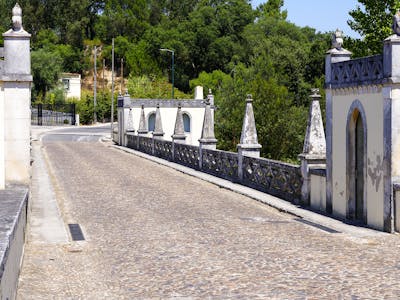The Batalha Monastery in Portugal stands as a masterpiece of Gothic and Manueline architecture. Commissioned in 1386 to celebrate the victory at the Battle of Aljubarrota, this UNESCO World Heritage site is a symbol of Portuguese national identity. Its façade shows meticulously carved details, while the interior mesmerizes with its soaring columns and ribbed vaults. The Founder's Chapel with its ornate tombs, adds a sense of solemn grandeur. The Batalha Monastery's rich history and architectural splendor make it a top destination, inviting visitors to delve into Portugal's past.
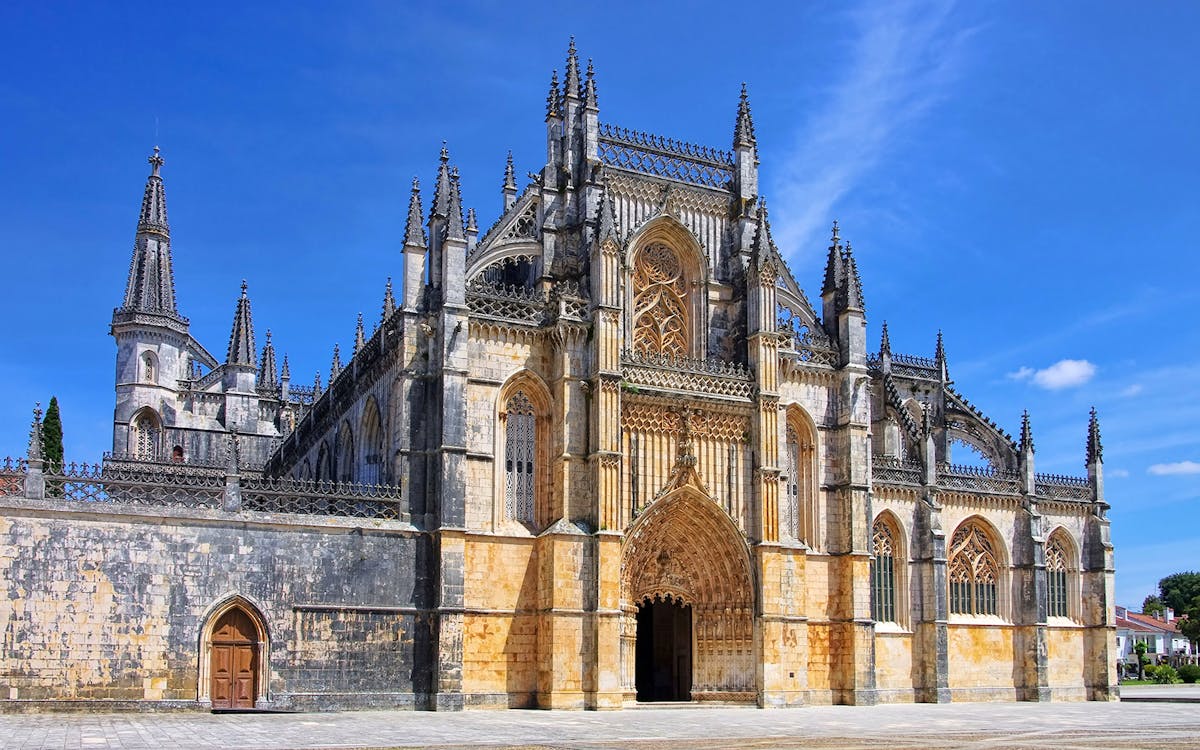
Batalha Monastery - In A Nutshell
Things to know
Completed in: 1517
UNESCO Designated: 1983
Type: National Monument
Opening Hours And Address
Oct 16 - Mar 31: 9 AM to 6 PM
Apr 1 - Oct 15: 9 AM to 6:30 PM
Closed: Jan 1, Easter Sunday, May 1 and December 25
Address: Largo Infante Dom Henrique, 2440-109 Batalha, Portugal
Get Directions
Why Is Batalha Monastery Worth Visiting?
- Explore a blend of Gothic and Manueline styles that make Batalha Monastery an architectural masterpiece.
- Dive into Portugal's history, commemorating the Battle of Aljubarrota and the nation's resilience.
- Admire the meticulously carved details of the monastery's façade, showcasing the skilled craftsmanship of the era.
- Witness the Founder's Chapel, adorned with ornate tombs and intricate religious artwork.
- Step inside to see the stunning soaring columns, ribbed vaults, and stained glass windows.
Batalha Monastery Tickets
History Of Batalha Monastery
The Batalha Monastery bears a history deeply rooted with the nation's struggles and triumphs. Construction began in 1386 by Portuguese architect Afonso Domingues, as a commemoration of Portugal's victory at the Battle of Aljubarrota. The battle marked a turning point in the country's fight for independence from Castile, and King João I vowed to build a monastery as a gesture of gratitude to the Virgin Mary for the triumph. The monastery was intended to be a testament to Portugal's resilience and as a final resting place for the royal family.
Over the centuries, the construction evolved, reflecting the evolution of architectural styles from Gothic to Manueline, showcasing intricate details and exquisite craftsmanship. The Founder's Chapel, dedicated to the memory of King João I and his queen, Philippa of Lancaster, stands as a stunning example of the artistry of that era. Today, as a UNESCO World Heritage site, the Batalha Monastery remains a testament to Portugal's historical journey, a beacon of artistic excellence and a symbol of national pride.
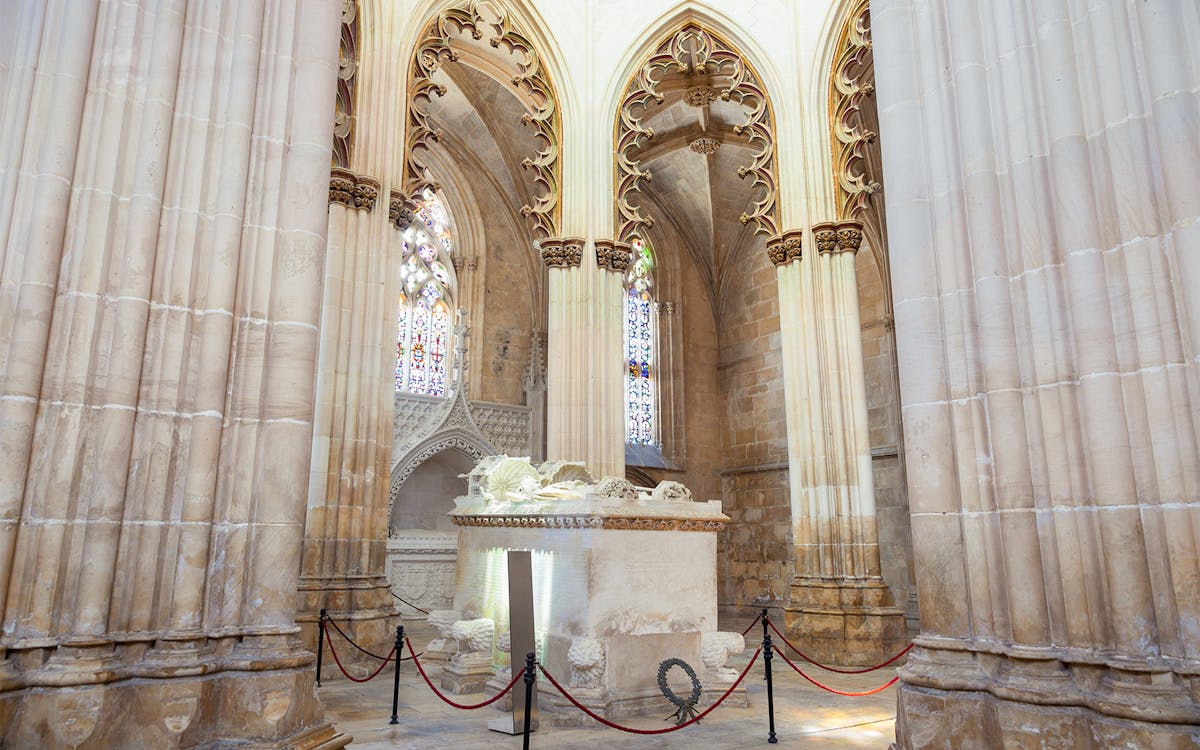
Batalha Monastery Architecture
The architecture of Batalha Monastery stands as a testament to the evolution of Gothic and Manueline styles, blending artistic innovation with historical significance. Designed by successive architects, including Afonso Domingues and Huguet, the monastery's façade reflects Rayonnant Gothic intricacy combined with hints of English Perpendicular design, reminiscent of renowned cathedrals like York Minster and Canterbury Cathedral.
Huguet's influence introduces Flamboyant Gothic elements, evident in the main façade, Founder's Chapel, and the intricate dome of the square chapter house. Notably, the Unfinished Chapels showcase his masterful touch, revealing delicate tracery and harmonious proportions. The monastery's soaring nave, reaching a remarkable 32.46 meters, exudes verticality while enhancing the sense of narrowness within.
The artistic dialogue between these architects spans from the late 14th to the mid-15th centuries, crafting a unique architectural narrative that captures Portugal's historical journey and cultural identity, making Batalha Monastery a fusion of innovation, craftsmanship, and historical legacy.
Top Highlights Of Batalha Monastery
1The Main Nave
The Main Nave of Batalha Monastery captivates with its soaring height of 32.46 meters, embodying a remarkable blend of Flamboyant Gothic and Manueline architectural styles. Its verticality enhances the sense of space and devotion, while intricate detailing and graceful proportions create an awe-inspiring sanctuary of artistic and spiritual significance.

2Tomb of John I and Philippa
Beneath the star vault of the octagon, the shared tomb of King John I of Portugal and Philippa of Lancaster resides. Sculpted in regal attire, their statues rest with clasped hands, symbolizing Portugal-England relations. Elaborate baldachins adorn their heads, creating a beautifully ornamented resting place.

3 Tombs of the four princes
The southern wall features recessed arches housing the tombs of John I's four younger sons and their spouses. Among them are Ferdinand the Holy Prince, John of Reguengos and his wife Isabella of Barcelos, Henry the Navigator, and Peter of Coimbra with his wife Isabella of Urgell.
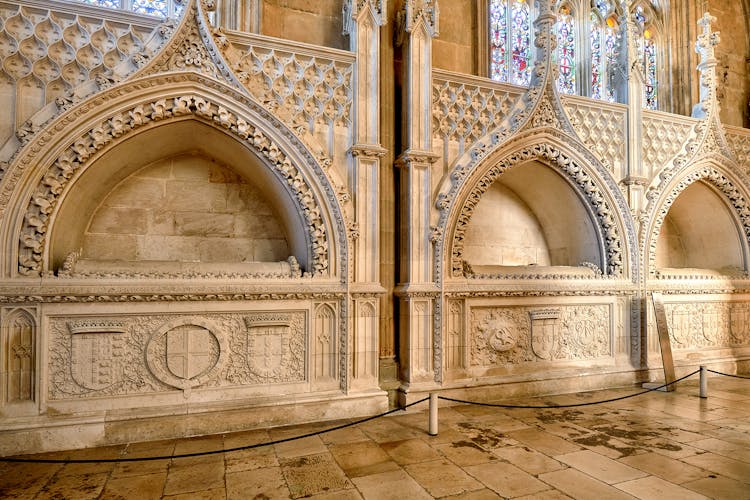
4The Unfinished Chapels
The Unfinished Chapels, distinct octagonal structures, serve as a reminder of the monastery's incomplete state. Attached via a retrochoir, they're externally accessible only. Commissioned in 1437 by King Edward of Portugal as a royal mausoleum, it houses only him and Queen Eleanor of Aragon.
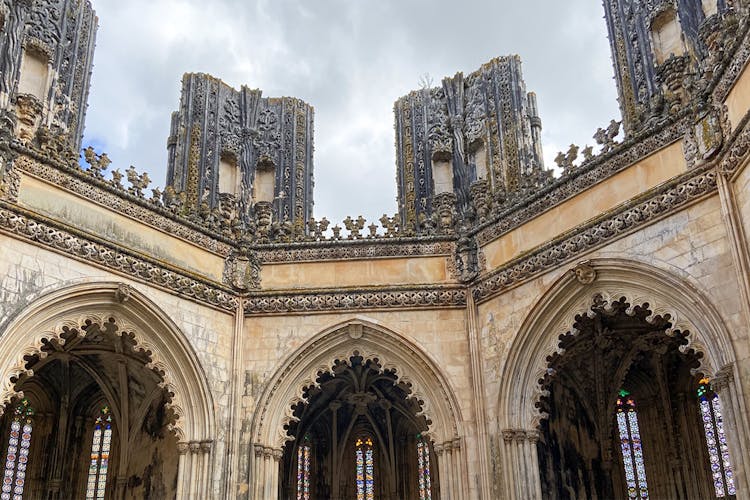
5The Chapterhouse
The Chapterhouse echoes the monastery's military origin. Two sentinels stand guard over World War I soldiers' tombs, recalling its martial roots. The room's standout feature is its unsupported star vault, spanning 19 meters per side, achieved with convict labor after two unsuccessful tries.

6Royal Cloister
Added later by architect Fernão de Évora, the Royal Cloister was absent from the original design. Its restrained exterior contrasts the church's Flamboyant Gothic style. Intricate Gothic tracery by Huguet within the ambulatory blends harmoniously with the Manueline arcade screens, an addition by Mateus Fernandes.

7Lavabo
In the northwest corner of Claustro Real, Lavabo, crafted by Mateus Fernandes, features a fountain with two elevated basins. Arching tracery enveloping it filters light, creating an illuminating effect.
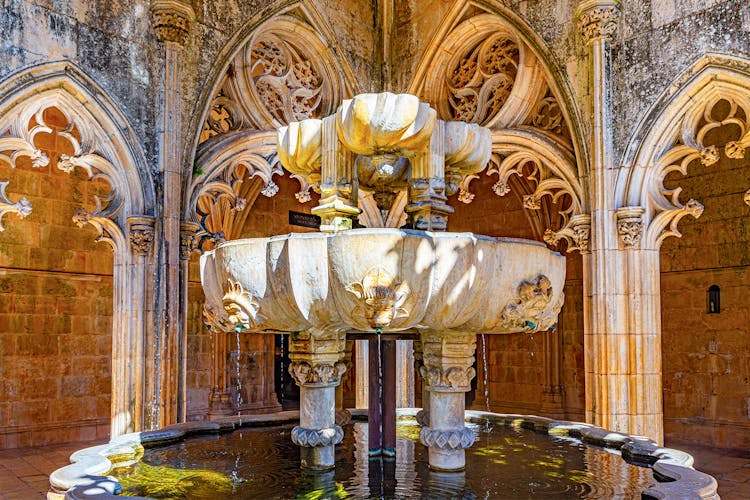
8Cloister of King Afonso
Adjacent to Claustro Real, the Cloister of King Afonso embraces conventional Gothic architecture with twin pointed arches. It provides a juxtaposition to the grandeur of Claustro Real's Manueline style. Vault keystones bear the coats-of-arms of D. Duarte I and Afonso V.
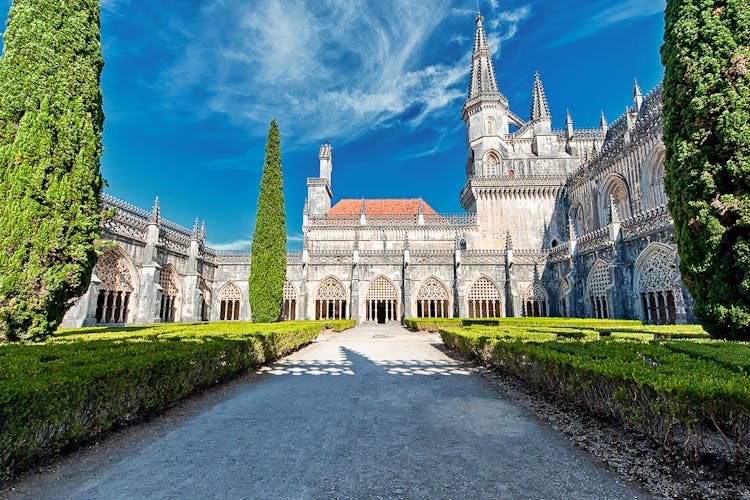
Best Time To Visit Batalha Monastery
The best time to visit Batalha Monastery is during the shoulder seasons of spring (April to June) and fall (September to October). The weather is pleasant, and there are fewer tourists, allowing for a more serene experience. The monastery's intricate details and outdoor spaces can be enjoyed comfortably. Additionally, attending during weekdays or early mornings enhances the chance to explore without the crowds, ensuring a seamless visit.
Batalha Monastery Timings
- October 15 to March 31: 9 AM to 6 PM
- April 1 to October 15: 9 AM to 6:30 PM
- Closed on: January 1, Easter Sunday, May 1 and December 25
Getting There
- Via a Guided Tour: This is probably the easiest way for you to to reach Batahla Monastery without any hassles. Book a guided tour that has all your transport arranged. Travel in a comfortable AC Bus!
- By Car: The closest parking lot is here.
- By Bus: Rede Expressos
The Rede Expressos goes from Lisbon to Batalha 5 times a day. It'll take you about 2 hours to reach. From the bus stop, the Batalha Monastery is a walking distance away. - By Train: Comboios De Portugal
The Comboios De Portugal train will drop you till Fatima, Ourem. From there you'll have to take a taxi to Batalha Monastery.
Insider Tips to Visiting Batalha Monastery
- Arrive at the monastery early in the morning to beat the crowds and enjoy the serene atmosphere.
- Opt for a guided tour to gain deeper insights into the history, architecture, and stories behind the monastery's intricate details.
- Plan your visit on a weekday to avoid the weekend rush and have a more personalized experience.
- Take advantage of the soft morning or late afternoon light for stunning photography, capturing the monastery's intricate façade and interior.
- Visit during spring or fall for pleasant weather and fewer visitors, allowing you to explore without the summer heat or winter chills.
- Engage with locals or staff to hear lesser-known tales about the monastery's history and the surrounding area.
- As a religious and historical site, dress modestly out of respect for the monastery's significance and cultural traditions.
Interesting Facts about Batalha Monastery
- The intricate star patterns on the vaulted ceilings of Batalha Monastery's chapels are thought to represent constellations, adding a celestial touch to the architecture.
- The remains of Queen Eleanor of Aragon, who died in exile, were brought back to Batalha Monastery after her passing, fulfilling her wish to rest beside her husband, King Edward.
- The daring unsupported star vault in the Chapterhouse proved so challenging that condemned prisoners were employed to construct it, adding a haunting layer to the monastery's history.
- The Founder's Chapel was designed with specific measurements to honor the number of days between significant events, such as the Battle of Aljubarrota and King João I's marriage.
Restaurants Nearby
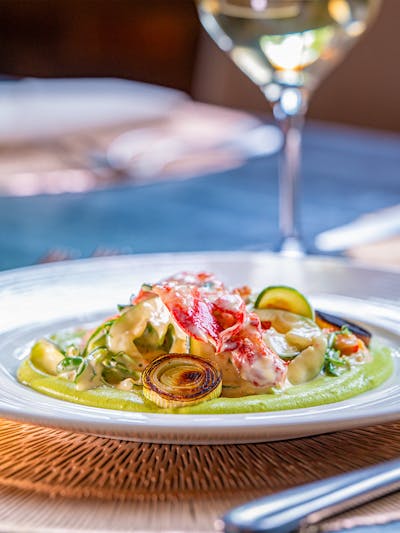
Burro Velho Restaurant entices diners with an array of high-quality meats, fresh fish, and seafood. Alongside a fixed menu, their tempting selection highlights creatively crafted dishes featuring meticulously chosen ingredients, often sourced from organic farming.
Distance from Batalha Monastery: 17 mt

Renowned for its authentic cuisine and grilled meats, Churrasqueira Vitória Restaurant stands out for its warm reception to both patrons and staff, fostering a familial and professional ambiance.
Distance from Batalha Monastery: 210 mt

Hamburgueria Enigma offers handcrafted hamburgers, pregos, steaks, and salads. Post-feast, patrons can unwind in the inviting ambiance, savoring cocktails, craft beers, and premium wines for a complete dining experience.
Distance from Batalha Monastery: 220 mt
Other Attractions around Batalha Monastery
Hotels around Batalha Monastery
FAQs
Batalha Monastery is a historical and architectural masterpiece in Portugal, known for its intricate blend of Gothic and Manueline styles, commemorating the Battle of Aljubarrota.
Batalha Monastery is typically open to visitors from 9:00 AM to 6:30 PM.
Yes, guided tours are available and highly recommended to gain deeper insights into the monastery's history and architecture.
Yes, photography is generally allowed, but flash photography might be restricted in certain areas to preserve the delicate artworks.
Plan for at least 1.5 to 2 hours to explore the main areas of the monastery, but you can spend more time if you're interested in detailed exploration.


